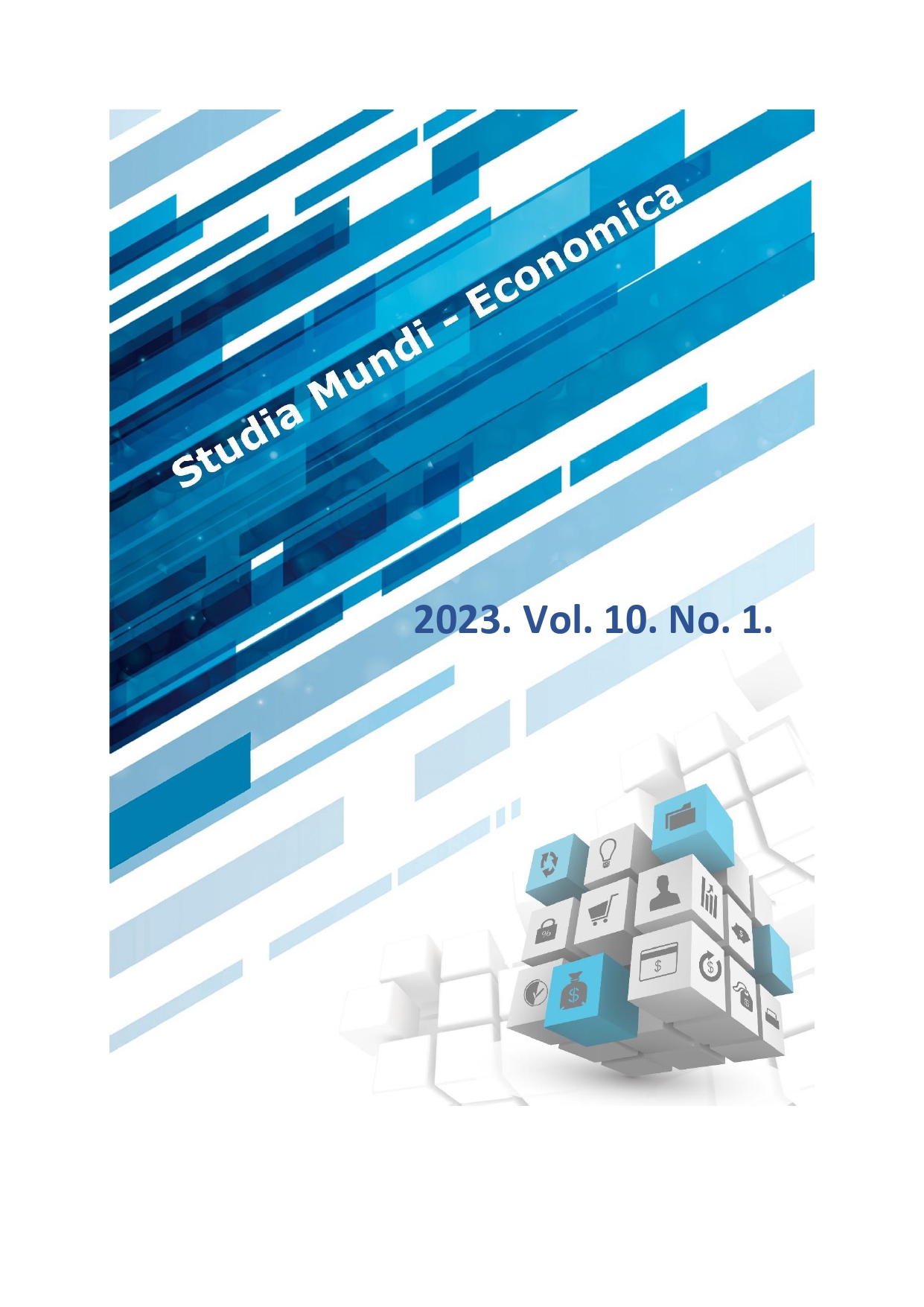The impact of industrial production growth on regional development in Hungary, 2009–2021
DOI:
https://doi.org/10.18531/sme.vol.10.no.1.pp.50-61Keywords:
regional economics, industrial production, Hoover-indexAbstract
The economic visions of the 1990s foresaw a number of trends for the 21st century that have generated significant changes. These changes were motivated by two major overarching factors: the vision of a knowledge society and the vision of a knowledge economy. The articulation of both factors has had such an impact on the development of education that we are witnessing the generation of continuous innovation trends. Taking a broad view of global trends, we can observe the erosion of competitiveness, increasing foreign competition, the overall effects of globalisation and liberalisation, the need to seek higher value-added and value-creating products and services, the need to move to more profitable and welfare-enhancing stages of production, the search for new sources of growth, the challenge of increasing total factor productivity, and the shift from an input-driven strategy to a productivity-driven strategy. In our study, we sought to answer the question of whether the increase in the value of industrial production has changed the spatial inequalities of production, and how the level and uneven spatial distribution of foreign direct investment affect the development of a given economic space in Hungary.
References
Áldorfai, Gy. – Nagy, H. – Tóth T. (2022): A területi egységek összetett teljesítményértékelése. Területi Statisztika, 62(4), 405–434. https://doi.org/10.15196/TS620402
Breschi, S – Malerba, F. (2005): Sectoral innovation systems: technological regimes, schumpeterian dynamics, and spatial boundaries. In Edquist, C. (Ed.): Systems of innovation. Technologies, institutions and organizations. Routledge, London – New York, 131–156.
Carlsson, B – Stankiewitz R. (1991): On the nature, function and composition of technological systems. Journal of Evolutionary Economics, 1(2), 93–118.
Casper, S – Sockise, D. (2004): Sectoral systems of innovation and varieties of capitalism: explaining the development of high-technology entrepreneurship in Europe. In MALERBA F. (Ed.): Sectoral systems of innovation: concepts, issues and analyses of six major sectors in Europe. Cambridge University Press, Cambridge, 348–387.
Cooke, P. – Laurentis, C. – Tödtling, F. – Trippl, M. (2007): Regional Knowledge Economies. Markets, Clusters and Innovation. Edward Elgar, Cheltenham – Northampton.
Edquist, C. (2005): Systems of innovation approaches. Their emergence and characteristics. In EDQUIST C. (ed): Systems of innovation. Technologies, institutions and organizations. Routledge, London – New York, 1–35.
Egri, Z. (2023): Mobilitás és perzisztencia a hazai települési szintű jövedelemegyenlőtlenségi folyamatokban, 2012–2019. Területi Statisztika, 63(1), 3–37. https://doi.org/10.15196/TS630101
Fagerberg, J. – Sapprasert, K. (2011): National Innovation Systems: The Emergence of a New Approach. Science and Public Policy, 38(9), 669–679.
Freeman, C. (1995): The “national systems of innovation” in a historical perpective. Cambridge Journal of Economics, 19(1), 5–24.
Gál, Z. (2019): Az FDI szerepe a gazdasági növekedés és a beruházások területi differenciáló-dásában Magyarországon. Közgazdasági Szemle, LXVI. (2019. június), 653–686. http://dx.doi.org/10.18414/KSZ.2019.6.653
Káposzta, J. – Lőrinc, B. (2023): Examining regional role of industrial production in transformation of Hungarian economic structure. Engineering for Rural Development, 22(1), 294–300. https://www.tf.llu.lv/conference/proceedings2023/Papers/TF059.pdf
Káposzta, J. – Nagy, H. (2022): The Major Relationships in the Economic Growth of Rural Space. European Countryside, 14(1), 67–86. https://doi.org/10.2478/euco-2022-0004
Kincses, Á. – Tóth, G. – Jeneiné Gerő, H. E. (2022): A hazai mikro-, kis- és középvállalkozá-sok (kkv-k) területi, versenyképességi elemzései, 2008-2020. Területi Statisztika, 62(4), 456–477. https://doi.org/10.15196/TS620404
Lee, T.-L. – Tunzelmann, N. (2005): A dynamic analytic approach to national innovation systems: The IC industry in Taiwan. Research Policy, 34(4), 425–440.
Lengyel, I. – Varga, A. (2018): A magyarországi gazdasági növekedés térbeli korlátai – helyzet-kép és alapvető dilemmák. Közgazdasági Szemle, LXV. (2018. május), 499–524. http://dx.doi.org/10.18414/KSZ.2018.5.499
Lőrinc, B. – Káposzta, J. (2022): Analysis of Regional Income Inequalities in Hungary between 2010 and 2019. Engineering for Rural Development, 21(1), 313–318. https://www.tf.llu.lv/conference/proceedings2022/Papers/TF098.pdf
Lundvall, B. A. (2007): National Innovation Systems – Analytical Concept and Development Tool. Industry and Innovation, 14(1), 95–119.
Lundvall, B. A. – Vang, J. – Chaminade, K. J. – Chaminade, C. (2009): Innovation system research and developing countries. In LUNDVALL B. A., CHAMINADE K. J. J., VANG J. (Ed.): Handbook of Innovation Systems and Developing Countries. Building Domestic Capabilities in a Global Setting. Edwar Elgar Publishing, Cheltenham – Northampton, 1–30.
Malerba, F. (2005): Sectoral systems of innovation: A framework for linking innovation to the knowledge base, structure and dynamics of sectors. Economics of Innovation and New Technology, 14(1–2), 63–82.
Molnár, T. (2015): Empirikus területi kutatások és módszerek. Akadémiai Kiadó, Budapest.
Nelson, R. R. (1993): National Innovation System. A comparative analysis. Oxford University Press, Oxford – New York.
Porter, M. E. (2000): Location, Clusters, and Company Strategy. In Clark, G. L. – Feldman, M. P. – Gertler, M. S. (eds): The Oxford Handbook of Economic Geography. Oxford University Press, Oxford, 253–274.
Sebestyénné Szép, T. – Szendi, D. – Nagy, Z.- Tóth, G. (2020): A gazdasági reziliencia és a városhálózaton belüli centralitás közötti összefüggések vizsgálata. Területi Statisztika, 60(3), 352–369. https://doi.org/10.15196/TS600303
EUROSTAT (2023): Production in industry (2013-2022) (Letöltve: 2023.03.02.)
KSH (2023): A lakónépesség nem, vármegye és régió szerint (2009-2021). Központi Statiszti-kai Hivatal – KSH, STADAT. (Letöltve: 2023.06.02.)
KSH (2023): Külföldi közvetlen tőkebefektetéssel működő vállalkozások külföldi tőkéje (2009-2021). Központi Statisztikai Hivatal – KSH, STADAT. (Letöltve: 2023.06.02.)
KSH (2023): Ipari tevékenység termelési értéke forgalmi adó nélkül, árbevételbe beszámító árkiegészítéssel (2009-2021). Központi Statisztikai Hivatal – KSH, STADAT. (Letöltve: 2023.06.02.)
Downloads
Published
Issue
Section
License
Copyright (c) 2023 Káposzta József, Lőrinc Balázs

This work is licensed under a Creative Commons Attribution-NonCommercial-NoDerivatives 4.0 International License.
A folyóirat Open Access (Gold). Cikkeire a Creative Commons 4.0 standard licenc alábbi típusa vonatkozik: CC-BY-NC-ND-4.0. Ennek értelmében a mű szabadon másolható, terjeszthető, bemutatható és előadható, azonban nem használható fel kereskedelmi célokra (NC), továbbá nem módosítható és nem készíthető belőle átdolgozás, származékos mű (ND). A licenc alapján a szerző vagy a jogosult által meghatározott módon fel kell tüntetni a szerző nevét és a szerzői mű címét (BY).






